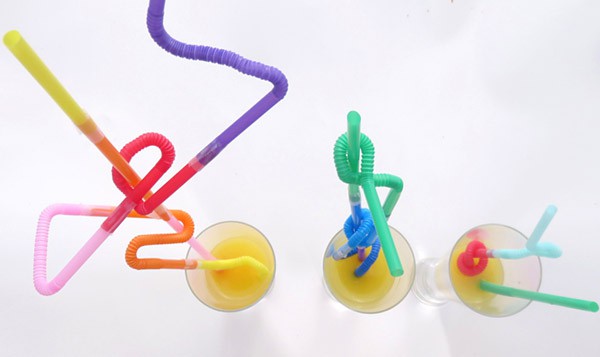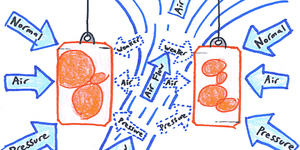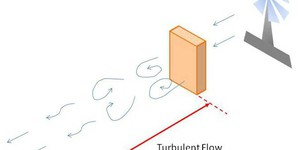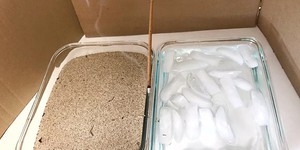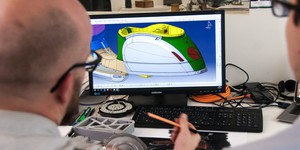Summary
Introduction
Have you ever used a crazy straw? Some spiral their way up. Others have fancy colors or decorations. Some are thin and others are wide. But just about all of them leave you sipping your drink from about the same distance. Why? Wouldn't it be fun to poke your head out of an upstairs window and secretly take a sip from a drink way below? Would it even be possible? With this activity, you'll see if you can set your own record for the longest working straw!
Materials
- A package of compostable or plastic straws (at least one dozen), preferably those with a bendable part
- Scissors
- Ruler
- Tape
- Drinking glass
- Water or juice
- Level surface that can get wet (or if not, something to protect it)
- Sturdy chair or table on which to stand
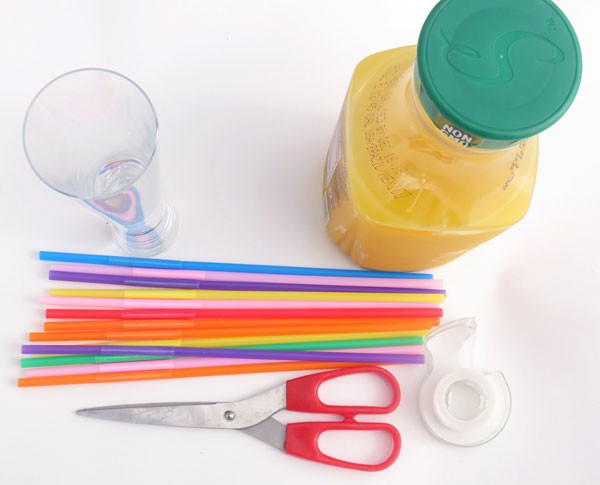 Image Credit: Sabine De Brabandere, Science Buddies / Science Buddies
Image Credit: Sabine De Brabandere, Science Buddies / Science Buddies
Prep Work
- Have an adult help to cut two half-inch slits, across from one another, lengthwise in one end of a straw. These cuts will help you slip the end of one straw over another one.
 Image Credit: Sabine De Brabandere, Science Buddies / Science Buddies
Image Credit: Sabine De Brabandere, Science Buddies / Science Buddies
- Prepare 10 more straws in a similar way until you have enough for a super long mega-straw! (You can also come back to these steps during the process in case you need more straws for your mega-straw.)
Instructions
- Slip the cut end of a prepared straw over the end of an unprepared straw.
 Image Credit: Sabine De Brabandere, Science Buddies / Science Buddies
Image Credit: Sabine De Brabandere, Science Buddies / Science Buddies
- Wrap the area where the straws overlap with tape so you have an airtight seal. Do not hurry; a good airtight seal will help you avoid trouble later.Why do you think a secure, airtight seal is essential for your mega-straw to function well? (Hint: When you drink with a straw, you must remove air from it.)
- To test your extra-long straw, put a glass of water on level ground. (Be sure to place something down to protect your level surface or use one that can get wet.) Now hold your straw vertically or close to vertically and try to drink with it.Does water reach your mouth?
- If little or no liquid enters the straw, check the seal where you joined the straws. Is it airtight? If not, add tape or undo and redo this connection. If the seals at all joints seem airtight, check for holes in other areas of your mega-straw and seal them with tape.
- Play around with your first mega-straw. Suck lightly to remove a little air from the straw then suck hard to remove more air. Observe each time how high the water rises in your mega-straw.What happens if you suck up more air? Why do you think this happens?
- Time to add on! Attach another prepared straw to your mega-straw in a similar way and put your lengthened mega-straw to the test. Remember to hold your straw vertically or close to vertically during your test.Is your new straw functioning properly? Does it get harder to suck up water?
- Keep adding prepared straws and testing after each addition. You might have to carefully stand on a chair to test your growing mega-straw.Does it become harder and harder to suck up water as you stand higher and higher above the glass?
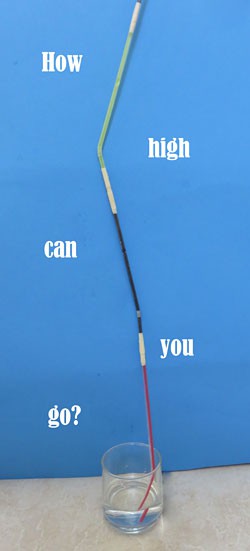 Image Credit: Sabine De Brabandere, Science Buddies / Science Buddies
Image Credit: Sabine De Brabandere, Science Buddies / Science Buddies
- Once you have connected a few straws together and it becomes a little challenging to drink with the straw, test your mega-straw at different angles. In addition to holding the straw vertically, test it at an angle about halfway between horizontal and vertical (approximately 45 degrees) as well as by holding it as close to horizontal as possible. Note that you might need to add more water to your glass to test a fairly horizontal position.Is there a difference in effort needed to suck up water?
- Rank the straw positions in descending order: 1 being the hardest to suck up water, or needing most effort; 3 being the easiest, or needing the least effort. Note that you did not change the distance over which the water was transported; the straw stayed the same length.Why would some straw positions make it possible to drink with less effort?
- Pause a moment and think about how the difference in height between your mouth and the glass changed depending on the angle at which you held the mega-straw. Rank the methods in descending order of difference in height between your mouth and the glass: 1 being the position with the most height difference; 3, the position with the least height difference.Do you see a relation between the difference in height and the effort you needed to suck up water?
- If you have bendable sections in your straw, test what happens if you keep the height of your glass and your head the same but change the way you bend the mega-straws.How do the levels of effort compare now that you keep the difference in height unchanged?
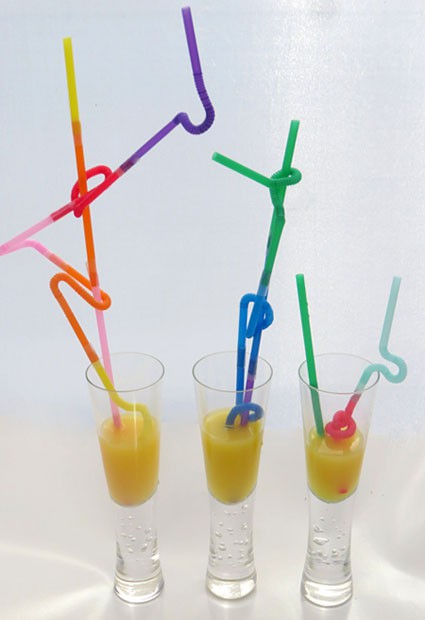 Image Credit: Sabine De Brabandere, Science Buddies / Science Buddies
Image Credit: Sabine De Brabandere, Science Buddies / Science Buddies
- Build on.How many straws can you connect before you can no longer drink from it if held vertically? Do you think there is a limit or would you be able to build on indefinitely, as long as you could test it from higher and higher places?
What Happened?
Air is constantly pressing on us and on the things around us. When you suck air from the straw, less air pushes on the water inside the straw than on the water outside of it. This imbalance causes more water to be pushed into the straw.
Suck harder, or remove more air from your mouth, and a bigger difference in air pressure will cause the water level to rise even higher into the straw. As soon as the water reaches the height of your mouth, you can drink.
Your lung power determines how much air you can remove. Some will have difficulty with a three-foot straw whereas others can successfully drink standing eight feet above their drink!
There is a limit though. If you could create a complete vacuum in your mouth by removing all the air, the water could rise about 30 feet high. It's not possible, however, to create a complete vacuum in the human mouth, so usually people reach their straw-slurping limit at a much lower level!
Note that it is mainly the difference in height the water needs to overcome that counts. Holding your straw almost horizontally will allow you to suck up water over a very long distance.
Digging Deeper
Sipping a drink through a straw might seem simple. But you are actually using some fancy air pressure changes to move your beverage. The sipping action occurs when you lower the air pressure in your mouth, which allows the atmospheric pressure to push the liquid up the straw.
Does that sound bizarre? Here is a little more explanation: The atmosphere is a massive layer of air. The weight of all that air is constantly pressing on us and on the things around us. At sea level, this invisible pressure is approximately 14.7 pounds per square inch. That is like having the weight of a bowling ball sitting on each square inch or five bowling balls pressing on the liquid filling a two-and-a-half-inch-diameter glass. Put a straw into liquid and the liquid will enter the straw until it reaches the same level as the liquid outside the straw. The liquid in the straw and around it is being pushed down by the air above it in a similar way, so they reach about the same level.
But it gets interesting when you remove some air from the straw. Suddenly, there is less air pressure inside and liquid is pushed up the straw. The more air you remove from the straw, the higher the liquid will be pushed into it. The water will rise until the pressure created by the water column in the straw equals the air pressure difference. If you could create a complete vacuum in your mouth by removing all the air, the water could rise about 30 feet high. It's not possible, however, to create a complete vacuum in the human mouth, so the straw-slurping limit for humans is at a much lower level.
Because you need to push the water up against gravity, it is mainly the difference in height the water needs to overcome that counts, not the total length the water needs to travel in the straw. You can suck up water over a very long distance holding your straw almost horizontally as long as there are no holes along the straw that let air in.
Ask an Expert
For Further Exploration
- Test with different types of straws, such as ones that are wide or very narrow. Would one type be more suited to make a mega-straw?
Related Resources
Project Ideas
Activities
Links
- Blog Post: Gas and the Size of a Marshmallow



